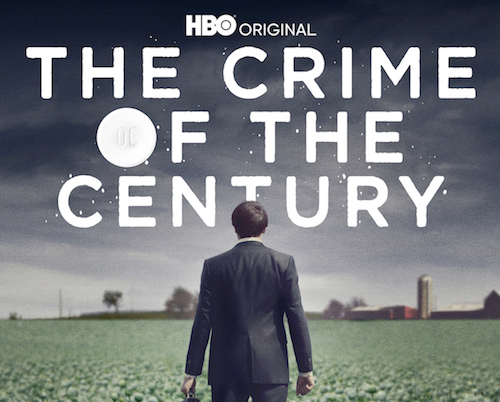HBO’s new documentary paints a damning picture of the corporate greed that has destroyed countless lives
By Mark Mravic
May 12, 2021HBO’s new documentary on the opioid crisis pulls no punches. Award-winning filmmaker Alex Gibney’s perspective is right there in the title: The Crime of the Century. And over the course of four hours (in two parts), the documentary serves as a searing indictment of the central figures in the healthcare crisis that has rocked America since the 1990s: pharmaceutical executives who pushed for ever-wider use of dangerous and addictive painkillers, and the enablers in politics, the legal establishment and regulatory agencies who allowed the disaster to unroll. All of it took place in the face of mountainous evidence of the most harrowing sort: the soaring death toll of everyday Americans, and millions of lives ruined.
To those in the treatment community, those who’ve battled opioid addiction or have seen friends or family members succumb to it, or really anyone paying attention over the past three decades, the story is familiar, if no less frightening. Numerous media investigations and full-length books have recounted the boom in the manufacture, sale and distribution of prescription opioids beginning in the 1990s that led to shocking new levels of addiction and overdose deaths.
What The Crime of the Century does, in relentless if somewhat stylized fashion, is lay out how it happened and who is to blame. Through archival footage, current-day interviews and previously unreleased documents, the film takes us step-by-step through an unfolding national catastrophe. Worst of all, it shows how that catastrophe was essentially deliberate, and avoidable.
Powerful drugs intended to ease the pain from end-of-life cancer, major surgery or severe injury were now being prescribed, in ever higher doses, for chronic backaches, ankle sprains and common sports injuries. And if patients became addicted, well, the problem was with them, not the drug.”
The Origins of the Opioid Epidemic
The main villains in the piece are the Sacklers, with their privately held Purdue Pharma. Gibney traces how patriarch Arthur Sackler brought Madison Avenue marketing techniques to the post-war prescription drug industry, discovering that, as one expert puts it, “doctors, whom we’re raised to think of as a custodian of our health, can be enlisted … in the interest of selling product.” By manipulating America’s most trusted professionals through persuasive (if deceptive) advertising, aggressive sales techniques and outright fraud, Purdue and other pharma companies could essentially create new markets for their drugs, driving unprecedented profits.
What Sackler did with the tranquilizer Valium in the 1960s, his family did at Purdue with the painkiller OxyContin in the ’90s. Drug maker Insys followed the same template with fentanyl in the 2010s. Powerful drugs intended to ease the pain from end-of-life cancer, major surgery or severe injury were now being prescribed, in ever higher doses, for chronic backaches, ankle sprains and common sports injuries. And if patients became addicted, well, the problem was with them, not the drug.
There is a fascinating but too brief discussion in The Crime of the Century of how the medical concept of pain and the role it plays in healthcare has evolved over the centuries, driving new notions of pain tolerance and management that may be well-meaning but ultimately helped fuel the opioid epidemic. The documentary strongly implies that for opioid companies, talk of patients’ quality of life was mere lip service in the pursuit of higher profits.

Indeed, the thread running through the four hours of The Crime of the Century is the strange place that the profit motive occupies in the American healthcare system. Two prominent former salespeople in the documentary—one for OxyContin, the other for fentanyl—confess that they were drawn to their jobs specifically by the “uncapped bonuses” their employers offered. For them, as for the companies as a whole, the priority became selling ever more product. Such a motivation might be fine for cars or washing machines, but it is perverse when the product is a dangerous drug. And when that philosophy played out on an industrial scale, the result was the opioid epidemic.
The personal stories of addiction’s toll contained in The Crime of the Century are, of course, gut-wrenching, and the denials and obfuscations of the pharma execs induce righteous rage. There is also the truly bizarre. Amidst the interviews and archival news footage, Gibney splices in absurd motivational music videos produced for pharma sales conferences—in one, a mulleted Purdue flak sings, “Selling OxyContin, every day,” to the tune of “Taking Care of Business”; in another, an Insys performer dressed as a giant fentanyl pill raps about increased titration levels and the wonders of the highly addictive opioid. Such scenes would be comic if not for the sick context. These people are literally singing and dancing as tens of thousands die.
A Tragedy That Could Have Been Averted
Still, The Crime of the Century argues persuasively that this massive episode of national self-harm could have been prevented, or at least mitigated, with stronger action by federal agencies. The Food and Drug Administration (FDA), rather than perform its rigorous regulatory role, allows Purdue to downplay or outright lie about the dangers of Oxy. (The drug’s approved documentation contained the wholly unsubstantiated claim that “delayed absorption of OxyContin is believed to reduce the abuse potential,” a marketing mantra that opens the floodgates to usage for indications far beyond end-of-life cancer.)
Even now, the financial settlements states have been reaching with Purdue and other pharma companies, while bringing in much-needed millions for treatment and prevention, mean that those responsible for the opioid epidemic mostly face no criminal repercussions, and information vital to a better understanding of the crisis … remains in the shadows.”
A years-long criminal investigation by prosecutors for the Western District of Virginia, which might have brought Purdue to heel, is quashed by the Bush Justice Department after heavy insider lobbying (the vampiric Rudy Giuliani even makes an appearance). Seemingly well-intended patients’ rights legislation, which in practice severely curtails the ability of the Drug Enforcement Administration (DEA) to crack down on illicit prescription drug distribution, is passed by Congress and signed by President Obama. All of it is very swampy.
Even now, the financial settlements states have been reaching with Purdue and other pharma companies, while bringing in much-needed millions for treatment and prevention, mean that those responsible for the opioid epidemic mostly face no criminal repercussions, and information vital to a better understanding of the crisis—where it came from, how it spread and how we might overcome it—remains in the shadows. It’s left to whistleblowers, journalists and committed documentarians like those behind The Crime of the Century to force the story into the light. May there be more of it.
The Crime of the Century, which debuted on May 10, is currently airing on HBO (check listings) and is available on demand at HBO and HBO Max.
Bottom photo: Einar Storsul














